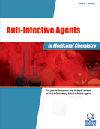- Home
- A-Z Publications
- Anti-Infective Agents in Medicinal Chemistry (Formerly Current Medicinal Chemistry - Anti-Infective Agents)
- Previous Issues
- Volume 5, Issue 4, 2006
Anti-Infective Agents in Medicinal Chemistry (Formerly Current Medicinal Chemistry - Anti-Infective Agents) - Volume 5, Issue 4, 2006
Volume 5, Issue 4, 2006
-
-
Tuberculosis: Current Treatment and New Drug Development
More LessMycobacterial infections, including tuberculosis (TB) and leprosy, are infectious diseases of global importance. Control of TB is complicated by difficulties in administrating the long-course chemotherapy regimens, the inability to eliminate latent organisms, and the increasing appearance of multidrug resistant strains of Mycobacterium tuberculosis . New drugs for the control of TB are urgently needed, including development Read More
-
-
-
Pharmacological Cyclin-Dependent Kinase Inhibitors (PCIs) as Potential Antiviral Drugs
More LessBy L. M. SchangTargeting viral proteins has led to many successful antivirals. However, such drugs have certain limitations. They rapidly select for resistance and tend to be active against only a few related viruses. And a significant time is required to identify and characterize targets encoded by new viral pathogens, a major concern in emerging diseases. As a result of such limitations, cellular proteins are now considered as potential targe Read More
-
-
-
Quinones and Malaria
More LessBy Jean FotieThe intensive usage and the efficacy of quinoline and artemisinin antimalarials have led scientists to focus mainly on these two families of compounds resulting in the other classes of antimalarial drugs being ignored. Recently atovaquone, a hydroxy-naphtoquinone derivative, was reported as an effective antimalarial drug against the multidrugresistant parasite with a novel drug mechanism. This discovery, which e Read More
-
-
-
Antisense DNA and RNA: Potential Therapeutics for Viral Infection
More LessAuthors: Ji Yuan, Travis Lim, Zhen Liu, Dexin Qiu, Brian Wong, Honglin Luo, Xiaoning Si, Bruce McManus and Decheng YangAntisense DNA and RNA are valuable tools to inhibit expression of a target gene in a sequence-specific manner. These molecules are not only widely used for gene functional study but also for therapeutic purpose. The strategy for therapeutics is attributed to its specific inhibition of gene expression of pathogens or disease-causing genes. Three types of anti-mRNA strategies can be distinguished, including antisense oligod Read More
-
-
-
Recent Advances in Pegylated Interferon Antiviral Therapy of Chronic Hepatitis C
More LessAuthors: Carla S. Coffin and Samuel S. LeeEffective hepatitis C antiviral treatment is important given the significant global morbidity and mortality from liver-related complications. Therapy for hepatitis C has advanced remarkably in the past two decades starting with interferon- alpha (IFN) monotherapy, followed by genetically engineered recombinant interferons (consensus IFN alpha) and subsequently IFN alpha in combination with the nucleoside analog ribavir Read More
-
-
-
Nematodes as Models for the Study of the Regulation of Activity of Pglycoproteins in Multidrug Resistance (MDR)
More LessAuthors: D. Kerboeuf and M. RiouAlterations in drug transport are a major cause of chemotherapy failures due to nonspecific resistance mechanisms. These mechanisms involve several ABC transporter proteins among which the P-glycoproteins have been the most extensively studied in vertebrates. Increased Pgp expression and/or activity in organisms leads to resistance to many chemically unrelated compounds and therapeutic agents. Such resis Read More
-
-
-
Antifungal Drugs for Systemic Mycosis: An Overview of Mechanism of Action and Resistance
More LessAuthors: J. S. Hamdan and R. C. HahnInvasive fungal infections are a frequent and important complication of modern medicine and remain important causes of morbidity and mortality, particularly in immunocompromised patients. In recent years, the existing antifungal armamentarium has been increased by new drugs and/ or improvement in older drugs. In this review, we summarise the current knowledge of the mechanisms of action and resistance of both n Read More
-
Most Read This Month
Article
content/journals/aiamc
Journal
10
5
false
en


